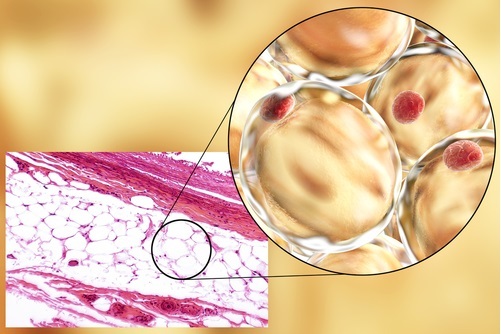
 Data Structure
Data Structure Networking
Networking RDBMS
RDBMS Operating System
Operating System Java
Java MS Excel
MS Excel iOS
iOS HTML
HTML CSS
CSS Android
Android Python
Python C Programming
C Programming C++
C++ C#
C# MongoDB
MongoDB MySQL
MySQL Javascript
Javascript PHP
PHP
- Selected Reading
- UPSC IAS Exams Notes
- Developer's Best Practices
- Questions and Answers
- Effective Resume Writing
- HR Interview Questions
- Computer Glossary
- Who is Who
What is White Adipose tissue (WAT) and Where Is It Found?
Introduction
White adipose tissue (WAT), also known as white fat, is a type of adipose tissue that plays a crucial role in energy storage and metabolism. It is the most abundant form of adipose tissue in the human body and is found primarily in the subcutaneous layer (under the skin) and around the internal organs such as the kidneys and heart.
WAT is composed of adipocytes, which are specialized cells that store energy in the form of triglycerides. Adipocytes make up approximately 20-25% of the total cell population in WAT and are surrounded by a network of blood vessels, immune cells, and connective tissue. The amount of WAT in the body can vary depending on factors such as age, sex, and overall health.

Location
White adipose tissue (WAT) is primarily found in the subcutaneous layer (under the skin) and around internal organs such as the kidneys and heart. In the subcutaneous layer, WAT provides insulation and protection, while around internal organs, it serves to cushion and protect these organs. WAT can also be found in other locations such as the bone marrow, breast tissue, and muscle tissue, although these depots are relatively small compared to subcutaneous and visceral depots. The amount of WAT in the body can vary depending on factors such as age, sex, and overall health.
Function
The primary function of WAT is to store excess energy in the form of triglycerides. When the body requires energy, such as during periods of fasting or exercise, WAT releases stored triglycerides into the bloodstream where they can be used by other tissues for energy production. WAT also plays an important role in regulating energy balance and metabolism by secreting hormones such as leptin, adiponectin, and resistin.
While WAT is essential for energy storage and metabolism, excess accumulation of WAT can lead to obesity and related metabolic disorders such as type 2 diabetes, cardiovascular disease, and certain types of cancer. Therefore, understanding the factors that regulate WAT formation and function is essential for the development of new treatments for these conditions.
WAT development and regulation are complex processes that involve a variety of factors such as genetics, diet, exercise, and hormonal signaling. During development, WAT originates from mesenchymal stem cells that differentiate into preadipocytes, which then differentiate into mature adipocytes. The process of adipocyte differentiation is regulated by a variety of transcription factors and signaling pathways, including peroxisome proliferator-activated receptor gamma (PPAR?), CCAAT/enhancer-binding proteins (C/EBPs), and insulin signaling.
In addition to genetic factors, diet and exercise also play important roles in the regulation of WAT formation and function. Consumption of a high-fat, high-calorie diet can lead to excessive accumulation of WAT, while caloric restriction and exercise can reduce WAT accumulation and improve metabolic health.
Hormonal signaling also plays a critical role in the regulation of WAT formation and function. Hormones such as insulin, glucocorticoids, and sex hormones can influence WAT development and metabolism through their effects on adipocyte differentiation, lipolysis, and insulin sensitivity.
Leptin is a hormone secreted by adipocytes that plays a critical role in the regulation of energy balance and metabolism. Leptin acts on the hypothalamus to suppress appetite and increase energy expenditure, thereby promoting weight loss. Deficiencies in leptin signaling have been linked to obesity and related metabolic disorders.
Adiponectin is another hormone secreted by adipocytes that plays a role in the regulation of glucose and lipid metabolism. Adiponectin increases insulin sensitivity and promotes fatty acid oxidation, thereby reducing the risk of insulin resistance and related metabolic disorders.
Resistin is a hormone secreted by adipocytes that has been implicated in the development of insulin resistance and related metabolic disorders. Resistin levels are elevated in obesity and may contribute to the development of type 2 diabetes and cardiovascular disease.
Conclusion
White adipose tissue (WAT) is an important type of adipose tissue that plays a crucial role in energy storage and metabolism in the human body.
WAT is regulated by a variety of factors, including genetics, diet, exercise, and hormonal signaling. Understanding the factors that regulate WAT formation and function is essential for the development of new treatments for obesity and related metabolic disorders such as type 2 diabetes and cardiovascular disease.
Further research is needed to fully understand the complex processes involved in WAT development and regulation and to identify new therapeutic targets for the prevention and treatment of these conditions.
FAQs
Q1. What is the difference between WAT and brown adipose tissue (BAT)?
Ans. WAT and BAT are two types of adipose tissue that serve different functions in the body. WAT is primarily involved in energy storage, while BAT is involved in energy expenditure through a process called thermogenesis. BAT is also characterized by its high mitochondrial content and the presence of uncoupling protein 1 (UCP1), which allows it to generate heat instead of ATP.
Q2. Can WAT be converted into BAT?
Ans. Yes, it is possible to convert WAT into BAT through a process called browning or beigeing. This process involves the induction of UCP1 expression and increased mitochondrial content in WAT, which allows it to generate heat and increase energy expenditure.
Q3. How does WAT contribute to obesity and related metabolic disorders?
Ans. Excessive accumulation of WAT can lead to obesity and related metabolic disorders such as type 2 diabetes, cardiovascular disease, and certain types of cancer. This is because WAT can secrete pro-inflammatory cytokines and hormones such as resistin, which can contribute to insulin resistance and inflammation in other tissues.

